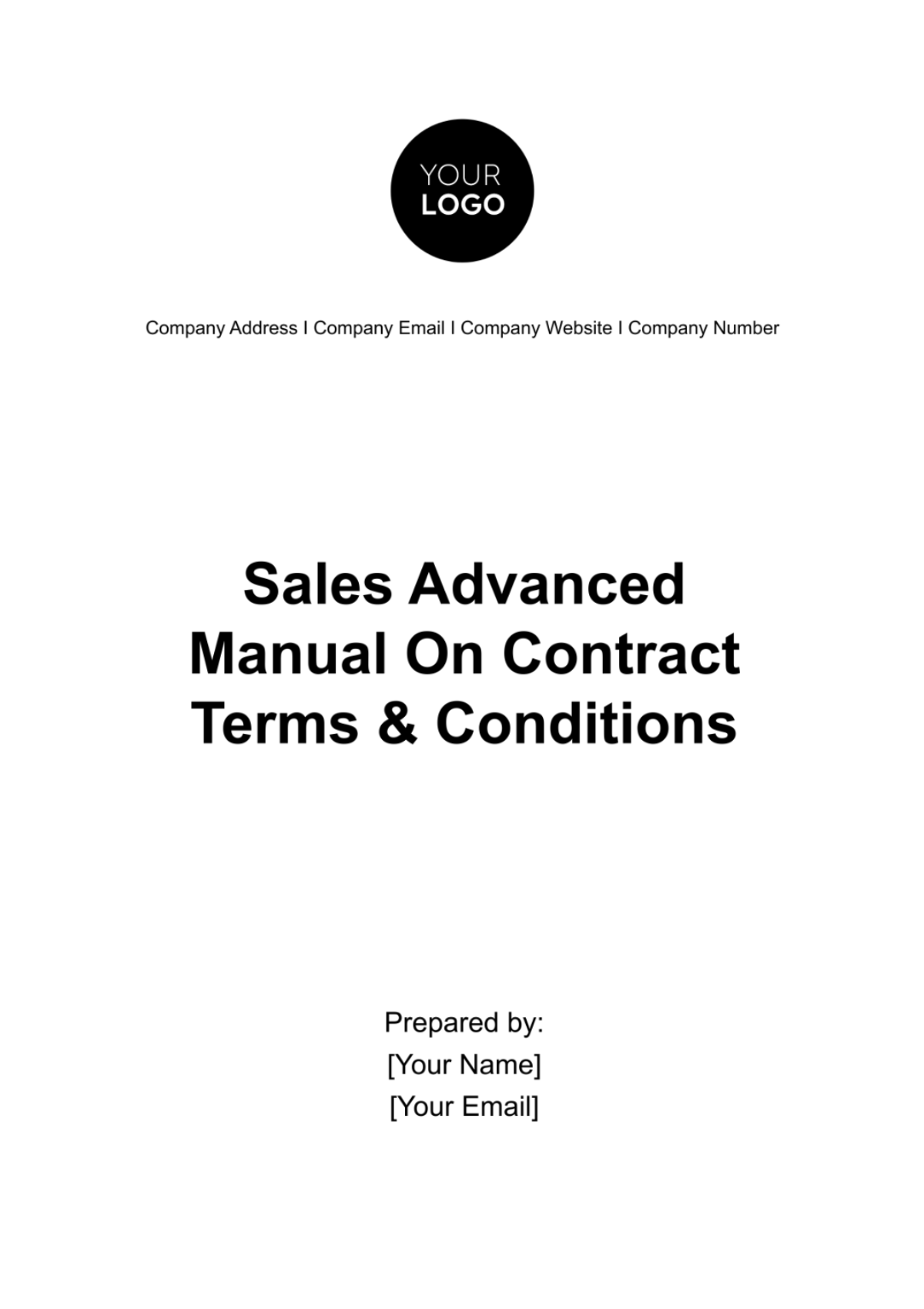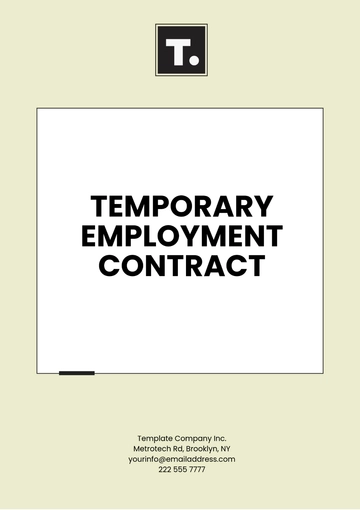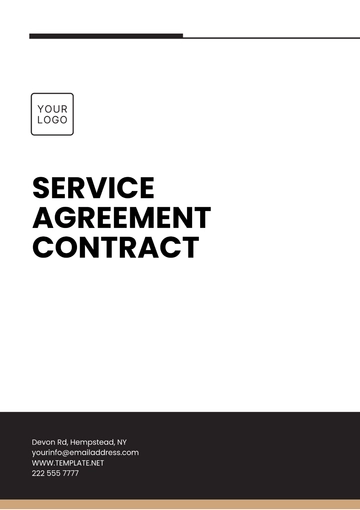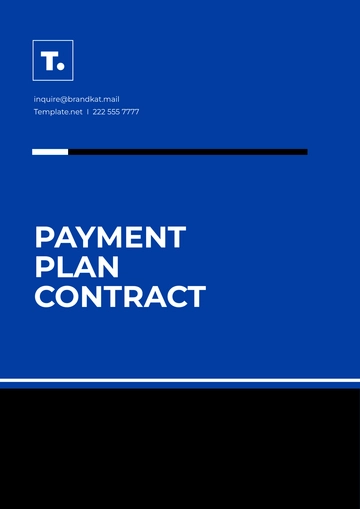Free Sales Advanced Manual on Contract Terms & Conditions

I. Introduction
Welcome to the Sales Advanced Manual on Contract Terms & Conditions for [Your Company Name]. In this comprehensive guide, we explore the intricacies of contractual agreements, equipping you with the knowledge needed to navigate the complex world of contracts effectively.
The primary purpose of this manual is to empower our team members, clients, and partners. By providing clear explanations, practical examples, and best practices, we aim to enhance your understanding of contract terms and conditions.
By offering understandable and clear elucidations of complex contractual terms, along with practical examples that highlight these terms in action, and a compilation of best practices one should adhere to, this guide aims to enhance and augment your comprehension of the ins and outs of contract terms and conditions. In essence, this manual is not just an informational guide, but a powerful tool meant to empower and educate all its users.
II. Understanding Contractual Nuances
A. Importance of Clear Terms
Clear and precise language within contracts serves as the bedrock of effective communication. When drafting contracts, consider the following aspects:
Avoiding Ambiguity
1.1. Ambiguous contract language can lead to misunderstandings and disputes. Imagine a scenario where a contract states, “Delivery will occur promptly.” What does “promptly” mean? Is it within hours, days, or weeks? Clarity is paramount to prevent such ambiguity.
1.2. To mitigate this risk, define terms explicitly. Specify delivery timelines, payment schedules, and performance expectations in unambiguous terms. When parties share a common understanding, the likelihood of disputes diminishes.
Legal Implications
2.1. Courts interpret contracts based on their language. The words you choose matter significantly. A seemingly innocuous phrase can have far-reaching consequences.
2.2. Consider a contract that states, “The vendor shall provide reasonable assistance.” What constitutes “reasonable”? Courts may interpret this differently. To avoid uncertainty, define “reasonable” in quantifiable terms—for example, “within 48 hours” or “up to three revisions.”
Risk Mitigation
3.1. Clear terms serve as a powerful risk management tool. When expectations are well-defined, parties can anticipate potential pitfalls and plan accordingly.
3.2. For payment terms, specify due dates, late fees, and acceptable payment methods. For termination clauses, outline notice periods and grounds for termination. By addressing these aspects explicitly, you protect your interests and minimize risk exposure.
B. Legal Framework
Understanding the legal context within which contracts operate is crucial:
Statutes and Regulations
1.1. Uniform Commercial Code (UCC) governs commercial transactions, including the sale of goods. Familiarize yourself with its provisions.
1.2. Additionally, explore the Restatement (Second) of Contracts, which provides guidance on contract principles.
1.3. The Electronic Signatures in Global and National Commerce Act (E-SIGN Act) addresses electronic signatures and records. Compliance with these regulations ensures the validity of your contracts.
Case Law
2.1. Court decisions shape contract interpretation. By studying relevant case law, you gain insights into how courts view specific contract provisions.
2.2. Stay informed about precedents affecting contractual rights and obligations. For instance, landmark cases related to contract formation, performance, and breach provide valuable lessons.
Contractual Freedom
3.1. While laws provide a framework, parties often have the freedom to negotiate terms. This contractual freedom allows customization to fit unique circumstances.
3.2. Balance legal requirements with practical business needs. Customize contracts to align with your specific industry, transaction type, and risk tolerance.
C. Creating Effective Contracts
Mastering the art of creating effective contracts involves several key considerations:
Structuring Agreements
1.1. Explore different contract formats based on your specific business needs. Whether it’s a purchase agreement, service contract, or joint venture agreement, tailor the structure accordingly.
1.2. Consider the hierarchy of clauses, headings, and subheadings. A well-organized structure enhances readability and clarity.
Key Elements of a Contract
Understand the building blocks:
2.1. Offer and Acceptance: Make valid offers and ensure proper acceptance.
2.2. Consideration: Explore the concept of consideration—the “something of value” exchanged between parties.
2.3. Capacity and Legality: Recognize the importance of parties’ legal capacity and the legality of the contract’s purpose.
III. Creating Effective Contracts
Crafting contracts that align with your business goals requires a strategic approach. Effective contracts are not mere legal documents; they are strategic tools that drive successful business relationships.
A. Structuring Agreements
When structuring agreements, consider the following steps:
Identify the Purpose of the Contract
1.1. Clearly define the purpose of the contract. Are you buying goods, securing services, or entering a joint venture?
1.2. Understanding the contract’s purpose ensures that all parties are on the same page.
Choose the Right Format
Different contract formats suit different scenarios. Tailor the format to your specific business needs:
2.1. Purchase Agreements: Used for buying goods or services. Specify product details, pricing, and delivery terms.
2.2. Service Contracts: Define the scope of services, deliverables, and payment schedules.
2.3. Joint Venture Agreements: For collaborative projects, outline responsibilities and risk-sharing mechanisms.
Hierarchy of Clauses
3.1. Arrange contract clauses logically. Start with essential terms (e.g., payment, delivery), followed by ancillary provisions (e.g., warranties, termination).
3.2. Use headings and subheadings to guide readers through the contract. A well-organized structure enhances readability and clarity.
B. Key Elements of a Contract
Understanding the essential elements of a contract is crucial:
Offer and Acceptance
Ensure that both offer and acceptance are clear and unambiguous:
1.1. Offer: One party proposes specific terms (e.g., price, quantity).
1.2.Acceptance: The other party agrees to those terms without modifications.
Consideration
2.1. Consideration refers to something of value exchanged between parties (e.g., money, services, goods).
2.2. Contracts require valid consideration to be legally binding. In a sales contract, the buyer’s payment is the consideration.
Capacity and Legality
3.1. Capacity: Parties must have the legal capacity to enter into contracts (e.g., not minors, mentally incapacitated individuals).
3.2. Legality: The contract’s purpose must comply with legal requirements. Contracts for illegal activities are void.
Mutual Assent
4.1. Both parties must genuinely agree to the terms.
4.2. The “meeting of the minds” ensures mutual understanding.
4.3. The Mirror Image Rule states that acceptance must mirror the offer.
C. Customization and Flexibility
Tailoring Contracts
1.1. Customize contracts to fit specific scenarios. No one-size-fits-all approach.
1.2. Address industry-specific requirements and unique business needs.
Balancing Legal Requirements with Practicality
2.1. While laws provide a framework, adapt contracts to practical realities.
2.2. Consider business objectives, risk tolerance, and industry standards.
IV. Common Contract Pitfalls and Mitigation Strategies
Contracts are intricate documents that require careful attention to detail. The following table highlights common pitfalls encountered during contract negotiations and execution:
Contract Pitfall | Mitigation Strategy |
Ambiguous language | Clearly define terms and avoid vague wording. Use precise language to prevent misunderstandings. |
Inadequate risk assessment | Conduct thorough risk assessments. Identify potential risks related to performance, payment, and force majeure events. |
Lack of dispute resolution mechanisms | Include clear provisions for dispute resolution (e.g., mediation, arbitration, or litigation). Specify applicable laws and jurisdiction. |
Failure to address change management | Anticipate changes (e.g., scope modifications, delays) and outline procedures for handling them. |
Ambiguity in contract language can lead to misunderstandings, disputes, and costly legal battles. Vague terms like “reasonable efforts” or “best efforts” lack precision and can be interpreted differently by parties. To mitigate this risk, contracts should define terms explicitly. Specify timeframes, quantities, and expectations. For instance, instead of using vague language, state specific delivery timelines or performance metrics. Clarity ensures that all parties share a common understanding.
Inadequate Risk Assessment can result in unforeseen consequences. Risks may include non-performance, financial losses, or legal liabilities. Thorough risk assessments are crucial. Identify risks related to performance, payment, and external factors (such as market changes or force majeure events). By understanding potential risks, you can implement mitigation strategies and allocate resources effectively.
Without clear provisions for dispute resolution, parties may end up in costly litigation. Disputes can disrupt business operations and strain relationships. Contracts should specify dispute resolution methods. Consider options such as mediation, arbitration, or litigation. Additionally, designate applicable laws and jurisdiction. Having a well-defined process ensures that disputes are resolved efficiently and fairly.
Contracts often encounter changes—scope adjustments, delays, or unforeseen events. Ignoring change management can disrupt project execution and strain relationships. Anticipate changes and outline procedures for handling them. Include change order processes, approvals, and communication channels. By addressing change management, you maintain project continuity and minimize disruptions.
Overall, contracts serve as the backbone of business relationships. Avoiding pitfalls ensures smooth operations, minimizes risks, and fosters trust. A well-crafted contract protects parties’ interests, promotes successful collaborations, and contributes to overall business success. By proactively addressing these common pitfalls, organizations can navigate contractual complexities with confidence.
V. Contract Negotiation Strategies
Effective contract negotiation is an art that requires finesse, strategic thinking, and adaptability. In this section, we explore proven strategies to enhance your negotiation skills and achieve favorable outcomes:
A. Preparing for Negotiations
Know Your Objectives and Priorities
1.1. Clearly define your goals before entering negotiations. Are you seeking better terms, cost savings, risk mitigation, or a combination?
1.2. Understand your priorities and be prepared to make trade-offs if necessary.
Research the Counterparty
2.1. Gather information about the other party. Understand their business, industry, and specific needs.
2.2. Identify potential areas of alignment and anticipate their concerns.
Anticipate Objections and Concerns
3.1. Put yourself in the shoes of the other party. What objections might they raise? How can you address them proactively?
3.2. Prepare well-reasoned responses to potential challenges, demonstrating your understanding of their perspective.
B. Effective Communication Techniques
Active Listening and Empathy
1.1. Listen actively to understand the other party’s perspective. Show genuine interest.
1.2. Ask clarifying questions and paraphrase their statements to demonstrate engagement.
1.3. Building rapport through empathy fosters a positive negotiation environment.
Building Trust and Rapport
2.1. Establish a positive relationship. Trust is essential for successful negotiations.
2.2. Find common ground, acknowledge shared interests, and show respect.
Avoiding Confrontation
3.1. Maintain a collaborative tone. Avoid adversarial language or aggressive tactics.
3.2 Focus on problem-solving rather than “winning” the negotiation.
C. Navigating Deadlocks and Impasses
Creative Problem-Solving
1.1. When negotiations stall, explore creative solutions. Brainstorm alternatives.
1.2. Consider win-win scenarios that benefit both parties. Look beyond traditional approaches.
Breaking Complex Issues into Smaller Components
2.1. Address one issue at a time. Break down complex matters into manageable parts.
2.2. Solve smaller problems incrementally to build momentum and maintain progress.
Seeking Mediation or Third-Party Assistance
3.1. If negotiations reach an impasse, consider involving a mediator or neutral third party.
3.2. Their fresh perspective can unlock solutions and bridge gaps.
VI. Frequently Asked Questions (FAQ)
Q: What is the purpose of a Terms and Conditions agreement?
A: A Terms and Conditions agreement outlines the rules and expectations between a business and its customers. It sets forth what customers can expect from the business and vice versa.
Q: Do I need a Terms and Conditions agreement?
A: While not legally required, having a well-crafted Terms and Conditions agreement is advisable for any business offering goods or services. It clarifies rights, responsibilities, and dispute resolution.
Q: What’s the difference between Terms and Conditions and Terms of Use?
A: Both serve similar purposes, but “Terms of Use” often specifically apply to website or app usage, while “Terms and Conditions” cover broader aspects of business interactions.
Q: Are Terms and Conditions legally binding?
A: Yes, they can be legally binding if they meet the elements of a contract. Offer, acceptance, consideration, and mutual assent are key components.
Q: Can Terms and Conditions be changed?
A: Yes, businesses can update their Terms and Conditions. Proper notice and acceptance mechanisms are essential for changes to be effective.
Q: How can I obtain acceptance of my Terms and Conditions?
A: Include acceptance mechanisms such as checkboxes during account registration or checkout. Users must actively agree to the terms.
Q: How can I ensure my Terms and Conditions are sufficiently clear?
A: Use precise language, avoid jargon, and organize the document logically. Clarity reduces ambiguity.
Q: What should Terms and Conditions include?
A: Key elements include payment terms, warranties, dispute resolution, intellectual property rights, and limitations of liability.
Q: Are Terms and Conditions legally binding if not signed?
A: Yes, acceptance can occur without a physical signature. Online acceptance (e.g., clicking “I agree”) is common.
Q: Why are Terms and Conditions important?
A: They protect both parties, set expectations, and provide a framework for resolving disputes.
- 100% Customizable, free editor
- Access 1 Million+ Templates, photo’s & graphics
- Download or share as a template
- Click and replace photos, graphics, text, backgrounds
- Resize, crop, AI write & more
- Access advanced editor
Understand contract terms and conditions effectively with the Sales Advanced Manual on Contract Terms & Conditions Template available only here on Template.net! This editable and customizable tool, which can be easily tailored with the help of our AI Editor Tool, provides a comprehensive manual on contract terms and conditions! Download now!
You may also like
- Rental Contract
- Contractor Contract
- Contract Agreement
- One Page Contract
- School Contract
- Social Media Contract
- Service Contract
- Business Contract
- Restaurant Contract
- Marketing Contract
- Real Estate Contract
- IT Contract
- Cleaning Contract
- Property Contract
- Supplier Contract
- Partnership Contract
- Food Business Contract
- Construction Contract
- Employment Contract
- Investment Contract
- Project Contract
- Payment Contract
- Student Contract
- Travel Agency Contract
- Startup Contract
- Annual Maintenance Contract
- Employee Contract
- Gym Contract
- Event Planning Contract
- Personal Contract
- Nursing Home Contract
- Law Firm Contract
- Work from Home Contract
- Software Development Contract
- Maintenance Contract
- Music Contract
- Amendment Contract
- Band Contract
- DJ Contract
- University Contract
- Salon Contract
- Renovation Contract
- Photography Contract
- Lawn Care Contract





























